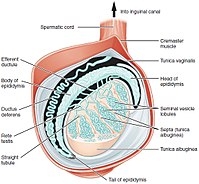
Photo from wikipedia
The SMAD protein family plays crucial roles in reproduction as a downstream target genes of the TGFβ signaling pathway. Many studies have focused on the expression change exploration of SMADs… Click to show full abstract
The SMAD protein family plays crucial roles in reproduction as a downstream target genes of the TGFβ signaling pathway. Many studies have focused on the expression change exploration of SMADs during testicular development and investigation of SMAD2 in hormone synthesis regulation. However, little attention has been given to determining the regulatory mechanism of SMADs in sheep testes. In the present study, we first detected SMAD mRNA expression levels in three-month-old (3 M), six-month-old (6 M), nine-month-old (9 M) and two-year-old (2Y) sheep testes. Different SMADs showed various expression patterns. In addition, the subcellular localization of SMAD2 was also analyzed, and Sertoli cells (SCs), Leydig cells (LCs) and spermatogonia presented mainly positive staining. Protein and nucleic acid sequence alignment showed that the SMAD2 gene was extremely homologous between various species. SMAD2 interference RNA was transfected into sheep LCs to examine the cell proliferation and hormone levels. The testosterone level was significantly decreased, and cell proliferation efficiency presented the same trend (P < 0.05). Moreover, SMAD2 downregulation promoted cell apoptosis (P < 0.05) and changed the cell cycle. In total, our results revealed that downregulating the expression of SMAD2 can effectively inhibit testosterone levels by affecting cell proliferation and apoptosis.
Journal Title: Theriogenology
Year Published: 2021
Link to full text (if available)
Share on Social Media: Sign Up to like & get
recommendations!